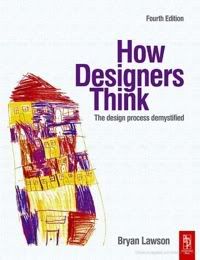 # Sugestão de leitura da semana:
# Sugestão de leitura da semana:Lawson, Bryan (2005). How designers Think: The Design Process Demystified. Architectural Press. ISBN-13: 978-0-7506-6077-8
alguns excertos:
(...)Design almost invariably involves compromise…. Rarely can the designer simply optimise one requirement without suffering losses elsewhere…. There are no established methods for deciding just how good or bad solutions are, and still the best test of most design is to wait and see how well it works in practice. Design solutions can never be perfect and are often more easily criticised than created, and designers must accept that they will almost invariably appear wrong in some ways to some people.(...)
(...)Once an idea has been formed and a design completed the world has in some way changed. Each design, whether built or made, or even if just left on the drawing-board, represents progress in some way…. Thus the completion of a design solution does not just serve the client, but enables the designer to develop his or her own ideas in a public and examinable way.(...)
(...)It is clear from our analysis of the nature of design problems that the designer must inevitably expend considerable energy in identifying the problems. It is central to modern thinking about design that problems and solutions are seen as emerging together, rather than one following logically upon the other…. [B]oth problem and solution become clearer as the process goes on.(...)
(...)[D]esign is essentially prescriptive whereas science is predominantly descriptive. Designers do not aim to deal with questions of what is, how and why, but, rather, with what might be, could be and should be. While scientists may help us to understand the present and predict the future, designers may be seen to prescribe and to create the future, and thus their process deserves not just ethical but also moral scrutiny.(...)
(...)Unlike the artist, the designer is not free to concentrate exclusively on those issues which seem most interesting. Clearly one of the central skills in design is the ability rapidly to become fascinated by problems previously unheard of…. Not only must designers face up to all the problems which emerge they must also do so in a limited time. Design is often a matter of compromise decisions made on the basis of inadequate information…. Designers, unlike scientists, do not seem to have the right to be wrong. While we accept that a disproved theory may have helped science to advance, we rarely acknowledge the similar contribution made by mistaken designs.(...)
Descrição:
"How Designers Think is based on Bryan Lawson's many observations of designers at work, interviews with designers and their clients and collaborators. This extended work is the culmination of forty years' research and shows the belief that we all can, and do, design, and that we can learn to design better. The creative mind continues to have the power to surprise and this book aims to nurture and extend this creativity. Neither the earlier editions, nor this book, are intended as authoritative prescriptions of how designers should think but provide helpful advice on how to develop an understanding of design. In this fourth edition, Bryan Lawson continues to try and understand how designers think, to explore how they might be better educated and to develop techniques to assist them in their task. Some chapters have been revised and three completely new chapters added. The book is now intended to be read in conjunction with What Designers Know which is a companion volume. Some of the ideas previously discussed in the third edition of How Designers Think are now explored more thoroughly in What Designers Know. For the first time this fourth edition works towards a model of designing and the skills that collectively constitute the design process."
Indice:
Part 1 - What is Design; Introduction; The changing role of the designer; Route maps of the design process;
Part 2 - Problems and Solutions: The components of design problems; Measurement, criteria and judgement in design; A model of design problems; Problems, solutions and the design process;
Part 3 - Design Thinking; Types and styles of thinking; Creative thinking; Guiding principles; Design strategies; Design tactics; Design traps; Design as conversation and perception; Towards a model of designing.
.
Sem comentários:
Enviar um comentário